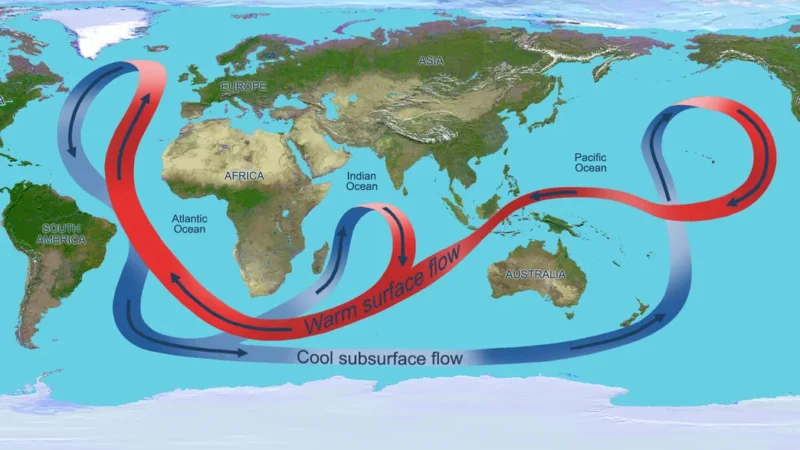- Recent research has revealed new evidence for a 2.4-million-year cycle – called an orbital resonance – between Earth and Mars.
- This dance of the planets now appears to affect Earth’s climate and, in turn, deep-ocean currents.
- The discovery came from ancient deep-sea cores.
Earth’s seabeds reveal ancient Martian influence
Geologists from the University of Sydney in Australia and the Sorbonne University in Paris have unearthed new physical evidence that a 2.4-million-year resonance in the orbits of Earth and Mars influences long-term earthly climate change. We know that warmer oceans result in more vigorous deep circulation. And this spring (March 2024), the researchers said they’ve found evidence in deep-sea cores showing shifts in sea currents that match the 2.4-million-year Earth-Mars cycle.
The international team of researchers published their peer-reviewed study in Nature Communications on March 12, 2024.
The data used to make the discovery came from ancient sedimentary cores. Scientists gathered these cores during more than 50 years of drilling the seafloor. The information – representing 65 million years of deposits – became part of a highly detailed virtual model of changes in Earth’s geology since its formation. The results enabled investigators to demonstrate that the strength of deep-ocean currents changes at the same frequency as the Earth-Mars orbital resonance.
Research team member and co-author Dietmar Müller of the University of Sydney said:
The gravity fields of the planets in the solar system interfere with each other and this interaction, called a resonance, changes planetary eccentricity, a measure of how close to circular their orbits are.
So, Earth has periods of greater incoming solar radiation in cycles of 2.4 million years, and thus an occasional warmer climate. And these warmer periods coincide with breaks in the deep-sea record that indicate a more vigorous deep-ocean circulation.
The press release also stressed:
These cycles are not linked to the current rapid global warming caused by human greenhouse gas emissions.
Ocean currents tied to Mars and Earth
In a press release from the University of Sydney, lead author Adriana Dutkiewicz described the researchers’ shock:
We were surprised to find these 2.4-million-year cycles in our deep-sea sedimentary data. There is only one way to explain them: they are linked to cycles in the interactions of Mars and Earth orbiting the sun.
In other words, they discovered distant Mars’ comings and goings relative to Earth strengthen and weaken deep-ocean currents. And that changes how sediments are deposited over endless eons.

Orbital cycles shape Earth’s changing weather, climate
We’ve known since early last century that orbital cycles directly influence Earth’s position and orientation. By changing the amount of sunlight striking Earth, those cycles cause the seasons. But they can also bring on ice ages or dry the planet out. NASA explained these climate drivers:
Cycles also play key roles in Earth’s short-term weather and long-term climate. A century ago, Serbian scientist Milutin Milankovitch hypothesized the long-term, collective effects of changes in Earth’s position relative to the sun are a strong driver of Earth’s long-term climate, and are responsible for triggering the beginning and end of glaciation periods (ice ages).
In the paper sharing the new geological evidence of gravitational influence, however, the scientists said they were looking for something a bit different:
Astronomical forcing of Earth’s climate is embedded in the rhythms of stratigraphic records, most famously as short-period (tens of thousands to hundreds of thousands of years) Milankovitch cycles. Astronomical grand cycles with periods of millions of years also modulate climate variability but have been detected in relatively few proxy records.
What they found was 65 million years of evidence in the geological record showing stronger deep-ocean currents when the gravity of Mars makes Earth’s oceans grow warmer.
Gravity between Mars and Earth, and warming
At its peak, Mars’ influence on Earth’s orbit significantly increases insolation, or the amount of sunlight striking the ground. And the increased insolation warms the entire climate every 2.4 million years. During those periods, according to the sedimentary record, deep-ocean eddies play an important role in circulation. These powerful eddies can be like whirlpools or tornadoes reaching the deep-ocean abyssal plain, eroding the seafloor, leaving snowdrift-like deposits – contourites – in their wake.
The ongoing influence of the Mars-Earth cycle could help mitigate ocean stagnation if the Atlantic meridional overturning circulation (AMOC) slows or stops. The AMOC drives the Gulf Stream, which in turn keeps Europe from slipping into another ice age. Recently, the Gulf Stream was measured at its weakest in more than 1,000 years. More worryingly, Nature Communications published a paper in July 2023 warning the AMOC could collapse by the middle of the 21st century, perhaps as early as 2025.
Mars-driven eddies and AMOC
Research team member and co-author Dietmar Müller of the University of Sydney said Mars-driven eddies might reduce the impact if the AMOC fails:
We know there are at least two separate mechanisms that contribute to the vigor of deep-water mixing in the oceans. AMOC is one of them, but deep-ocean eddies seem to play an important role in warm climates for keeping the ocean ventilated. Of course, this would not have the same effect as AMOC in terms of transporting water masses from low to high latitudes and vice-versa.
Dutkiewicz said the team hopes their paper will result in better climate modeling. Their findings may also provide a bit of hope and somewhat alleviate climate-driven angst, she said:
Our deep-sea data spanning 65 million years suggest that warmer oceans have more vigorous deep circulation. This will potentially keep the ocean from becoming stagnant even if Atlantic Meridional Overturning Circulation slows or stops altogether.
Bottom line: International researchers studying ancient seafloor sediments have found new evidence that a 2.4 million-year-long resonance between the orbits of Earth and Mars affects long-term changes in ocean temperatures and currents.
Source: Deep-sea hiatus record reveals orbital pacing by 2.4 Myr eccentricity grand cycles
Read more: Mars in 2024: Find it before dawn in the morning sky
Read more: Chart showing Mars oppositions from 2018 to 2033

Dr. Thomas Hughes is a UK-based scientist and science communicator who makes complex topics accessible to readers. His articles explore breakthroughs in various scientific disciplines, from space exploration to cutting-edge research.



/cdn.vox-cdn.com/uploads/chorus_asset/file/25498857/lenovo_tab_plus_1.jpg)




